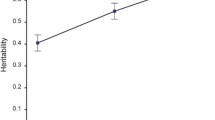Abstract
This study presents the assessment of inbreeding depression on the intelligence quotient among north Indian Muslim Children of school age. The Weschler Intelligence Scale for Children (WISC-R)-74 was given to the children in both groups (50 each non-inbred and inbred of the first-cousin status), aged 6 to 11 years and from the same socio-economic status. The change of the mean follows genetic theory; however, the nature of the change in variance seems to be somewhat different.
Similar content being viewed by others
References
Adams, M. S., and Neel, J. V. (1967). Children of incest.Pediatrics 40:55–62.
Afzal, M. (1988). Consequences of consanguinity or cognitive behaviour.Behav. Genet. 18:583–593.
Afzal, M., and Badaruddoza (1990). A preliminary study on inbreeding effects on intelligence quotient profile among Sunni Muslims of Aligarh.Biol. Bull. Ind.,12:1–8.
Afzal, M. and Sinha, S. P. (1983). Consanguinity effect on intelligence quotient and neonatal behaviours of Ansari Muslim children.Proc. Ind. Natl. Sci. Acad. B,46(5):407–411.
Afzal, M., and Sinha, S. P. (1984). Effect of consanguinity on intelligence quotient of Bilhari Muslim Children. In Manna, G. K., and Sinha, U. (eds.)Perspectives in Cytology and Genetics; Vol. 4, pp. 114–117.
Agrawal, N., Sinha, S. N., and Jensen, A. R. (1984). Effect of inbreeding on Raven matrices.Behav. Genet. 14:579–585.
Badaruddoza and Afzal, M. (1991). Inbreeding in human population.Man in India 2(4):431–453.
Barrai, L., Cavalli Sforza, L. L., and Mainardi, M. (1964). Testing a model of dominant inheritance for metric traits in man.Heredity 19:651–668.
Bashi, J. (1977). Effects of inbreeding on cognitive performance.Nature 226:440–442.
Basu, S. K. (1985). Inbreeding in India, Its genetic consequences and implications in health care. InPopulation Genetics and Health Care; Issues and Future Strategies, NIHFW, New Delhi.
Böök, J. A. (1957). Genetical investigations in a North Swedish population. The offspring of first cousin marriages.Ann. Hum. Genet. 21:191–221.
Carter, C. O. (1967). Risk to offspring of incest.Lancet 1:436.
Cohen, T., Block, N., Flam, Y., Kadar, M., and Goldschmidt, E. (1963). School attainments in an immigrant village. In Goldschmidt, E. (ed.),The Genetices of Migrant and Isolate Population, Williams & Wilkins, Baltimore.
Crow, J. F., and Kimura, M. (1970).An Introduction to Population/Genetics Theory, Harper & Row, New York.
Dickinson, A. G., and Jinks, J. L. (1956). A generalised analysis of diallel crosses.Genetics 41:65–78.
Falconer, D. S. (1981),Introduction to Quantitative Genetics, Oliver and Boyd, Edinburgh.
Jensen, A. R. (1978). Genetics and behavioural effects on nonrandom mating. In Osborne, R. T., Noble, C. E. and Weyl, N. (eds.),Human Variation: The Biopsychology of Age, Race, and Sex, Academic Press, New York, pp. 51–105.
Jensen, A. R. (1983). The effects of inbreeding on mental ability factors.Personal. Indiv. Diff. 4:71–87.
Kamin, L. J., (1980). Inbreeding depression and IQ.Psychol. Bull. 87:469–479.
Li, C. C. (1955)Population Genetics, University of Chicago Press, Chicago.
Mather, K. (1949).Biometrical Genetics, Methuen, London.
Neel, J. V., Schull, W. J., Yamamote, M., Uchida, S., Yanase, T., and Fujiki, N. (1970). The effects of parental consanguinity and Inbreeding in Hirado, Japan. II Physical development, tapping rate, blood pressure, intelligence quotient, and school performance.Am. J. Hum. Genet. 22:263–266.
Niswander, J. D., and Chung, C. S. (1965). The effects of inbreeding on tooth size in Japanese Children.Am. J. Hum. Genet. 17:390–398.
Reed, W. E., and Reed, S. C. (1965).Mental Retardation: A Family Study, Saunders, Philadelphia.
Schull, W. J., and Neel, J. V. (1965).The Effects of Inbreeding on Japanese Children, Harper & Row, New York.
Schull, W. J., and Neel, J. V. (1972), The effects of Parental consanguinity and inbreeding in Hirado, Japan. V. Summary and interpretation.Am. J. Hum. Genet. 24:425–453.
Schwartz, M., and Schwartz, J. (1974). Edivence against a genetical component to performance on IQ tests.Nature 248(5443):84.
Seemanova, E. (1971). A study of children of incestuous matings.Hum. Hered. 21:108–128.
Slatis, H. M., and Hoene, R. E. (1961). The effect of consanguinity on the distribution of continuously variable characteristics.Am. J. Hum. Genet. 13:28–31.
Wright, S. (1921). Systems of mating. II. The effects of inbreeding on the genetic composition of a population.Genetics 6:124–143.
Author information
Authors and Affiliations
Rights and permissions
About this article
Cite this article
Badaruddoza, Afzal, M. Inbreeding depression and intelligence quotient among north Indian children. Behav Genet 23, 343–347 (1993). https://doi.org/10.1007/BF01067435
Received:
Accepted:
Issue Date:
DOI: https://doi.org/10.1007/BF01067435




